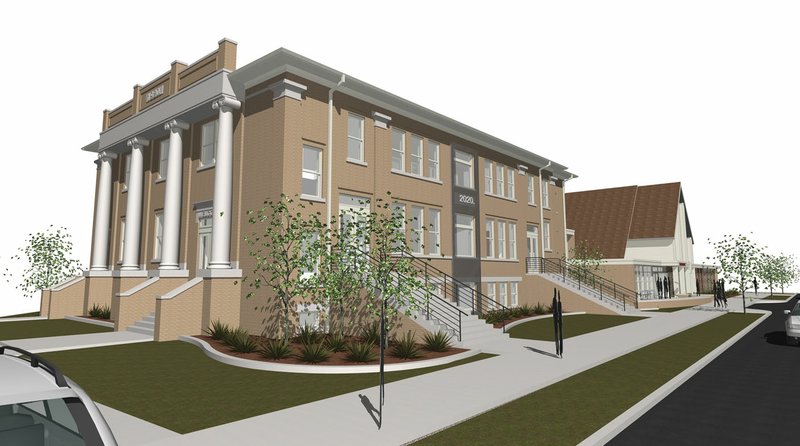The historic First United Methodist building in downtown will be renovated on its 100th anniversary to create a ministry center.
The white-columned structure, located at the corner of Maxwell and Twin Springs streets, was originally built in 1920 and was most recently leased to Sager Creek Arts Center, according to Clark Atkins, senior pastor. Church members voted in 2016 to renovate the 17,000-square-foot building in two phases and construction on phase one is set to begin in 30 to 60 days, he said. The project is estimated to take approximately one year.
The project aims to create a space where people, especially children and youth, can connect with Christ, Atkins said.
Phase one, which will cost an estimated $1 million, will update and reconfigure the walls on all three floors of the interior of the building, including the stage and sanctuary area. The project will include the addition of an elevator and handicap-accessible restrooms on each floor and two interior fire exits, as well as a new heating and air system, electrical system and plumbing.
"The building needs a lot of TLC," Atkins said. "It's got great bones for a 100-year-old building. It's very sturdy, but all the electrical is original, the plumbing is original, stained glass windows -- everything in there is original."
The church plans to continue to use the renovated basement for youth group meetings for middle and high school students, and create a space for the Timothy Team, a group for younger students, in the main floor, along with an indoor play area, Atkins said. The third floor will include multi-use areas and possibly even space to share with a nonprofit, if the church can find the right partner, he said.
"We really want this to be more than just a building for our church, but really for the community to be a resource, which could include possibly a rainy-day site for things going on at the amphitheater," Atkins said. "We have a fellowship hall we open for community use and we have always seen part of our role of being downtown as being a community resource and we want to be able to expand that."
The exterior of the building will see little change, other than cleaning and repairs, Atkins said. The two large stained glass windows have been sent off for storage and repair. The smaller stained glass windows will have to be removed because they contain hazardous materials and experts told church members that encasing the windows in glass would not protect them but instead only cause them to deteriorate more quickly, he said.
Phase two, which will cost an estimated $300,000 and will take place at a later date, will connect the ministry center with the current sanctuary, providing a recognizable entrance for the church and a welcoming space where people can gather.
The church is working with architect Matt Pearson and construction manager Steve Marshall of The Marshall Group to plan the project, Atkins said.
The Methodist Church presence in Siloam Springs dates back to Simon Sager, the town's first settler, who hosted Methodist church services in his log cabin in the 1830s, according to a transcript of church history. In the early years, Siloam Springs had two Methodist congregations -- the Methodist Episcopal Church and the Methodist Episcopal Church, South, the document states.
The 1920 building was constructed by the Methodist Episcopal Church, South, and was actually the sixth Methodist church facility to be built in Siloam Springs, Atkins said. The church was constructed for a cost of $60,000 the year after John Brown University was established and John Brown Sr. was on the building committee, Atkins said. The two congregations united in one building in 1940 as the First United Methodist Church.
"It's a grand lady, it really is," said Joallen Moose, who chairs the capital campaign for the renovation with Richard McCarver. "One Sunday I was sitting out front and I thought about that first Sunday, all the prayers and dedications and covenants that were made for the use of the building and that to me is a great motive for getting it back to where it ought to be."
The church's present sanctuary was constructed just east of the original building in 1958, according to church history. The current fellowship hall was added in 1978, Moose said. Even though the 1920 building hasn't been used for religious services since the 1950s, the church has always had a presence there and the basement is currently being used for student ministries for grades seven through 12, Atkins said. Many members, now in their 80s, remember being baptized in the former sanctuary, he said.
Currently about 50 students attend Wednesday night youth services, which include a meal, according to Mannie Anchando, youth and children team leader. The services aim to reach underserved youth and the renovations will give them a dedicated space to be kids, he said.
Over the past five months, members and friends of First United Methodist Church have given approximately $650,000 towards the $1.3 million needed for the renovations as part of the For Their Future Capital Campaign, Atkins said. The campaign is named after many of the individuals in the past who have built buildings and payed forward for future generations, he said. Many of the donations came in the form of small amounts from individuals, he said.
Earlier this month, an anonymous donor committed $350,000 over three years, with a challenge to the congregation and community to commit the last $300,000 needed to fully fund the project through matching gifts, Atkins said.
"With the funds we've raised thus far, the new pledge and matching gifts, we would reach the $1.3 million needed to renovate the ministry center without long-term debt," Atkins said. "The opportunity to complete the ministry center in this way is a tremendous blessing."
General News on 03/29/2020
